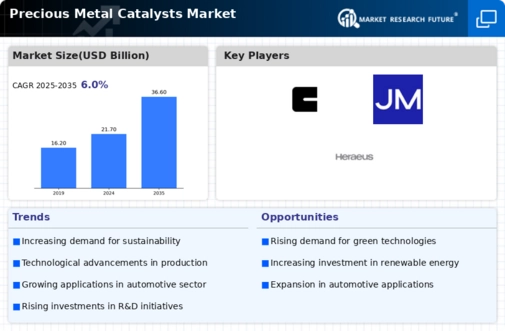Market Share
Precious Metal Catalysts Market Share Analysis
In the competitive landscape of the Precious Metal Catalysts Market, companies employ various market share positioning strategies to establish a strong foothold and gain a competitive edge. One prevalent approach involves product differentiation, wherein companies strive to distinguish their catalysts based on unique features, quality, or advanced technologies. This strategy not only helps attract customers but also allows companies to command premium prices, contributing to higher profit margins. By investing in research and development, companies can stay ahead in the innovation curve, ensuring that their catalysts outperform competitors in terms of efficiency and performance.
Another crucial aspect of market share positioning in the Precious Metal Catalysts Market is effective pricing strategies. Some companies adopt a cost leadership approach, aiming to provide catalysts at lower prices than their competitors. This strategy requires efficient cost management, economies of scale, and streamlined production processes. Alternatively, premium pricing strategies are employed by companies emphasizing superior quality, innovation, or brand value. This allows them to target a niche market segment willing to pay a premium for top-notch catalysts.
Strategic alliances and partnerships play a significant role in market share positioning within the Precious Metal Catalysts Market. Collaborations with key industry players, research institutions, or suppliers can provide access to complementary resources, technologies, or distribution channels. Joint ventures and partnerships enable companies to pool their strengths and capitalize on synergies, ultimately enhancing their overall market position. These alliances also contribute to a broader market presence, allowing companies to tap into new customer bases and geographies.
Market segmentation is another key strategy employed by companies in the Precious Metal Catalysts Market to optimize their market share. By identifying specific customer needs and tailoring catalysts to meet those requirements, companies can create targeted marketing campaigns and products that resonate with distinct market segments. This approach allows for a more focused and efficient use of resources, ensuring that companies address the unique demands of different industries or applications.
Continuous improvement and adaptation to market trends are essential for maintaining and expanding market share in the dynamic Precious Metal Catalysts Market. Regularly updating product portfolios, incorporating feedback from customers, and staying abreast of technological advancements are crucial components of this strategy. By being responsive to market changes, companies can proactively address evolving customer preferences and stay ahead of competitors.
Geographical expansion is a vital market share positioning strategy in the Precious Metal Catalysts Market. Companies often target untapped markets or regions with growing industrial activities. This expansion may involve establishing new manufacturing facilities, distribution networks, or partnerships with local entities. By strategically entering new markets, companies can broaden their customer base and diversify their revenue streams, reducing dependence on specific regions or industries.






Leave a Comment